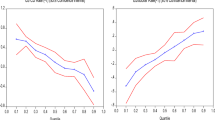Conclusion
This note has examined interest rate and monetary base linkages within the EMS. Cointegration tests suggest the existence of a long-run equilibrium relationship between German and other EMS interest rates and German and other EMS country monetary bases in a number of cases. Bivariate VAR analysis suggested that Granger causality with respect to EMS interest rate linkages stemmed either from German to European markets or was bi-directional and that the monetary base linkages were overwhelmingly bi-directional. When allowance is made for the influence of US monetary policy developments, the pattern of Granger causality within the EMS is predominantly bi-directional. These findings may be attributable to integrated financial markets and the discipline of a formal exchange rate mechanism. Thus, our results fail to support the hypothesis that German monetary policy plays a dominant and independent role within the EMS. Rather, they suggest that monetary policies in the EMS mainly respond to each other and, to a very limited extent, to developments in US monetary policy.
Similar content being viewed by others
References
Akaike, H. (1969). Fitting Autoregressive Models for Prediction.Annals of the Institute of Statistical Mathematics 21 (l):243–247.
Artis, M. J. (1987). The European Monetary System: An Evaluation.Journal of Policy Modelling 9(1): 175–198.
Artis, M. J., and M. P. Taylor (1994). The Stabilizing Effect of the ERM on Exchange Rates and Interest Rates.IMF Staff Papers 41 (1): 123–148.
Biltoft, K., and C. Boersch (1992). Interest Rate Causality and Asymmetry in the EMS.Open Economies Review 3 (3): 297–306.
DeGrauwe P., (1991). Is the EMS a DM-zone? In A. Steinherr and D. Weiserbs (eds.),Evolution of the International and Regional Monetary Systems. London: Macmillan.
Dickey, D. A., and W. A. Fuller (1979). Distribution of Estimates of Autoregressive Time Series with Unit Root.Journal of the American Statistical Association 74 (2): 27–31.
Engle, R. F., and C. W. J. Granger (1987). Co-Integration and Error Correction: Representation, Estimation, and Testing.Econometrica 55 (2): 251–276.
Fratianni, M., and J. von Hagen (1990). German Dominance in the EMS: The Empirical Evidence.Open Economies Review 1 (1): 67–87.
Hansen, G. (1996). The Domestic Term Structure and International Interest Rate Linkages: A Cointegration Analysis.Weltwirtschaftliches Archiv 132 (4): 675–689.
Johansen, S., and K. Juselius (1990). Maximum Likelihood Estimation and Inference on Cointegration — With Applications to the Demand for Money.Oxford Bulletin of Economics and Statistics 52 (2): 169–210.
Karfakis, J. C., and D. M. Moschos (1990). Interest Rate Linkages within the European Monetary System: A Time Series Analysis.Journal of Money, Credit, and Banking 22 (3): 388–394.
Katsimbris, G. M., and S. M. Miller (1993). Interest Rate Linkages within the European Monetary System: Further Analysis.Journal of Money, Credit, and Banking 25 (4): 771–779.
Kutan, A. (1991). German Dominance in the European Monetary System: Evidence from Money Supply Growth Rates.Open Economies Review 2 (3): 285–294.
Rogoff, K. (1985). Can Exchange Rate Stability Be Achieved without Monetary Convergence?European Economic Review 28 (1/2):93–115.
Taylor, M. P., and M. J. Artis (1988). What Has the European Monetary System Achieved? Bank of England Discussion Paper 31. London.
vonHagen, J., and M. Fratianni (1990). German Dominance in the EMS: Evidence from Interest Rates.Journal of International Money and Finance 9 (4): 358–375.
About this article
Cite this article
Thornton, J., García-Herrero, A. Additional evidence on monetary base and interest rate linkages in the EMS. Weltwirtschaftliches Archiv 133, 359–368 (1997). https://doi.org/10.1007/BF02707468
Published:
Issue Date:
DOI: https://doi.org/10.1007/BF02707468




